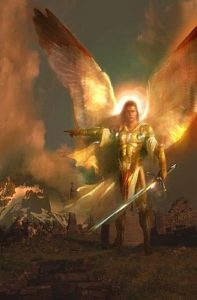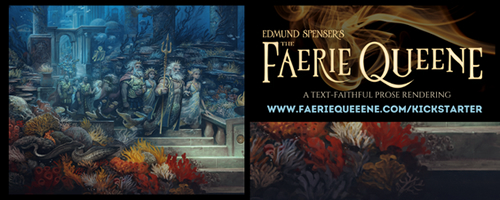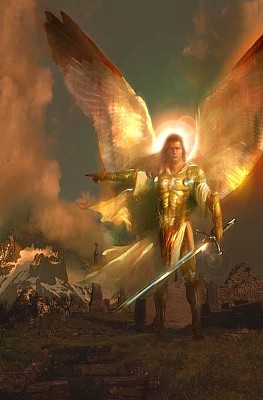Fantastic Tropes and Where To Find Them
(Every story has them: tropes, cliches, hackneyed plot “twists” — common ideas that can’t help getting repeated. Whole websites are devoted to ridiculously addictive attempts to catalog every single trope in every single “secular” story. Naturally, Christian novels, especially speculative ones, aren’t immune from this phenomenon. Here is a partial list, as originally published here.)
I’ve been reading a lot of Christian spec-fic lately, and I keep noticing repeats. Certain elements everybody loves, like the Chosen One or Nephilim. These things are called tropes. In the interest of improving Christian spec-fic as a whole, I’ve decided to compile a list of these tropes and present them for your education. Or amusement. Or both.
Aliens. There are no aliens, only Nephilim.
Alien planets. These are not allowed. If humans aren’t on Earth, how would God find them for the Rapture?
Altar-call Ending. Sometimes this ending is the reason the book was written in the first place. The Hero goes to a Church/Chapel/Cathedral, kneels before the altar, and accepts the Christ-figure with a fantasy-ized version of the Sinner’s Prayer. Usually this is directed straight at the reader.
 Angels. Winged musclemen in white robes who fly around with fiery swords, beating down demons. See This Present Darkness. Occasionally an angel will appear as a smiling young man in a white shirt who mysteriously helps the hero or dispenses advice, then vanishes. This is sometimes confusing, because the Christ-figure does the same thing.
Angels. Winged musclemen in white robes who fly around with fiery swords, beating down demons. See This Present Darkness. Occasionally an angel will appear as a smiling young man in a white shirt who mysteriously helps the hero or dispenses advice, then vanishes. This is sometimes confusing, because the Christ-figure does the same thing.
The Antichrist. According to Revelation, this is some dude who gets possessed by Satan and becomes the One World Leader. At first he’s good, then he turns bad and starts chopping off heads (of Christians). The ultimate big bad, most Christian books wind up trying to prevent his rising or fight him when he comes. See Left Behind.
Armor of God. This is a physical suit of armor that represents the one in Ephesians — the Helmet of Salvation, the Belt of Truth, and so on. The Sword of the Spirit and the Shield of Faith are usually the most important parts. Commonly seen in post-apocalyptic stories.
The Bad Girl. This is the harlot/tramp/whore who exists only to tempt the Hero from his path of righteousness. She only cares about her own pleasure. We’re treated to graphic descriptions of her entire body except her breasts. She usually works for the Antichrist.
The Bible. This is called anything but the Bible. The Book of Light, the Holy Book, the Holy Writings, the Sacred Scriptures. But it’s always the Bible and grants either obscure knowledge or superpowers. Expect clumsily-reworded Bible verses.
Breasts. No woman has these. We might be told that she has some nice “assets”, or that she wore a shirt that showed off her chest. But breasts, as we know them, do not exist. Perhaps women in Christian fiction have udders instead.
The Chosen One. This is a kid, or a guy, who goes on a quest to find the lost artifacts, or the birthright, or the sage, or something, that will help him defeat the Big Bad. See Antichrist.
The Chosen One’s story is “yet another medieval setting with overt Christian allegories during the tale of [an] orphan who turns out to be the lost son of royalty about whom there is an ancient prophecy that he will defeat evil and bring peace.” — E. Stephen Burnett, Speculative Faith
Christ-figure. There is always one of these. He might be a man in a white robe, or he might be a lion or some other sacred animal. He shows up to give the Hero advice, help the Hero when the Hero has reached his lowest point, or in rare cases, actually do something interesting like swing the battle in the good guys’ favor. In other words, the Christ-figure is a literal deus ex machina.
Death. An unpleasant way for the hero and supporting cast to go hang out with the Christ-figure.
Demons. Insidious beings of pure evil. They appear as either patches of living darkness (see the Vashta Nerada) or as scaly lizard-like beings that breathe out sulfur fumes through long fangs. They can also appear only as a whisper in the hero’s ear telling him what a failure he is. Demons can only be slain by angels and occasionally good Dragons. Occasionally the most devout Chosen One can exorcise them.
Dragons. Most dragons are evil because they represent Satan. Some dragons, however, swing too far the other direction and are just dinosaurs with spikes and sometimes wings. Sometimes, you might meet a dragon that is the traditional fantasy type, breathes fire and has wings. But these are hard to find.
The Future. Christian science fiction can’t look too far ahead because of the Rapture and the Antichrist. There’s no future past that.
God. Generally a caricature of the Christian God, God is a distant deity who sits in heaven and allows bad things to happen to people to make them come to a better relationship with Him. Sometimes God answers prayers or resurrects someone, or heals a wound at a crucial moment. There will usually be a conversion scene where the Chosen One, guided by the Christ-figure, will come to believe in God. Then the Chosen One will get all kinds of Divine Power and beat down the bad guys with it. God is a Deus ex machina.
Heaven. A glowy gold place with lots of light and people who have already crossed over. The hero’s murdered parents/girlfriend/grandparents/best friend are always shown hanging out here, waiting for the hero to encounter Death and join the party.
 Magic. There are only two kinds of magic: Holy and Demonic. Because all magic comes from God or Satan. There is no neutral magic, and thus no neutral magical practitioners, even in high fantasy worlds with otherwise standard fantasy rules. Good magic is only used for healing and defense, making everyone either a Paladin or a Cleric. Black magic is used for mind control, summoning demons, and other, far more interesting things.
Magic. There are only two kinds of magic: Holy and Demonic. Because all magic comes from God or Satan. There is no neutral magic, and thus no neutral magical practitioners, even in high fantasy worlds with otherwise standard fantasy rules. Good magic is only used for healing and defense, making everyone either a Paladin or a Cleric. Black magic is used for mind control, summoning demons, and other, far more interesting things.
Magic can also come from Science. Science magic is basically a superpower, like increased magnetism, or super-developed brain lobes to allow telekinesis or telepathy. This kind of magic squeaks past the Occult-radar because it’s more like Spider-Man.
Monsters. Monstrous creatures are always 100% bad, whether they’re genetically engineered, part human, or anything in between. Monsters seem to ascribe to the action movie school of thought, where everything and its brother is out to single-mindedly eat the hero.
Nephilim. These are half-human, half-fallen-angel people. There are no aliens, elves, mermaids, dwarves, or any other fantasy race. There are only Nephilim. They can be tall and handsome with pointy ears, or tall and ugly, or tall with big round eyes like aliens. They can be any combination of man and animal (man + horse, man + goat, man + fish). The Rephaim and the Anakim are almost never mentioned.
The Pure Girl. This girl is the Right Choice for the Chosen One. She’s kind, helpful, supportive, and never thinks about sex. She is the Proverbs 31 Woman. If the hero is not saved, the Pure Girl will show him the error of his sinful ways and guide him to repentance.
The Rapture. The only future allowed to Christians. This is when God returns to Earth and vacuums up all the Christians, leaving behind all the bad people for judgment. This is when the Antichrist takes over. Usually has elements of an Ultimate Escape Fantasy followed by seven years of Ultimate Revenge Fantasy.
Satan. The original mustache-twirling villain, always out to take over the world. Satan is always behind every bad thing happening, no matter how fantastic the world.
Sex. This is only allowed if it’s part of a character’s backstory and involves rape or some kind of abuse. Sometimes, depending on the publisher, the abuse can be very graphic. This is so the heroine can be Saved by God later in the book, and learn to love the Chosen One. Love scenes between two married people are never as graphic as the abuse scenes.
Snakes. See Dragons.
Villains. Often the villain is the most likeable character in the whole book. He may be a misguided rogue, waiting for the Christ-figure to show him the error of his ways. Or he is a psychopath, possessed by Satan or a demon, bent entirely on destruction.






































This gave me a chuckle. So true!
Occasionally an author can and does do something fresh and fun even with these familiar tropes. I enjoy the occasional “Chosen One” who doesn’t turn out to be stunningly handsome and incredibly skilled with weapons he has never before handled. . .but ordinary chosen guys don’t show up often enough.
My guess is that writers are reluctant to take liberties when portraying God in their books, which is why they lift Scripture passages almost whole-cloth for their own holy book. It is a rather tricky thing, after all, to put words in the mouth of a being who is supposed to represent Yahweh. Some readers get upset when an allegory doesn’t dovetail perfectly with reality, or even just with reality-as-the-reader-views-it.
Just my thoughts.
Somebody delete that Gino Shayne thing. It’s a spam.
Just did. Ugh, that was an especially annoying sneaky-spammer, too.
This is great, especially the part about slipping neutral magic past the reader as sciency stuff. I’ve seen a few books try and do otherwise, but for some reason writers are afraid to just say “This is a different world, which uses magic like we do electricity.”
Also the breasts line made me laugh out loud. I am so going to break this trope the next time I write.
Careful not to rip on This Present Darkness, on account of…it’s AWESOME.
Also, if anyone mentioned “breasts” in Christian fiction, I can’t imagine the conniption that would follow from the “Soul Surfer movie may as well be porn” crowd…
Great article! Amusing to say the least…
(Throws arms about my brother.)
Thank you, brother. I also love This Present Darkness and its sequel (though Peretti’s best work remains The Visitation). Yes, there’s some superstition, yes, it leans toward the notion of “specific demons cause specific diseases,” but what they hey? It’s imagination. If people take it too far, it’s (mostly) their fault. And it’s awesome.
I have, however, seen plenty of less-awesome writers try to imitate the concepts!
Similarly, for me, Soul Surfer would be porn. For others, it might not be. Beauty may be in the eye of the beholder, and so is a little too much beauty, if you catch my wave.
It was good, but it really did influence Christian spec-fic tropes in a bad way though. Roger Elwood’s “Angelwalk” was a nice subversion of it: in the book, it’s the angel who is in danger, and risking falling to earth due to evil.
I listen to Peretti’s readings of both “Darkness” books every couple years. I loved “Monster,” and I also love all the “Cooper Kids Adventure” books, which I devoured repeatedly as an early teen. He was one of the first great “cinematic writers” that I read and as one of the first in the world of modern Christian pop culture to be better than his “secular” counterparts…and that while the afforementioned CPC was trying to convince itself that Petra was good rock n roll. Let’s not bring up the steaming turd of a book that Dekker and Peretti put out together (and which someone thought was a good idea to make into a movie). Let’s just pretend that never happened…
Re: Soul Surfer, just busting your chops. It’s how I express brotherly affection.
Why, I never show affection in such insensitive ways …
Ah, I did not know Peretti himself had read for both Darkness audiobooks. “Has someone been reading my Christmas list?” Only recently, by the way, did I re-obtain a copy of Piercing the Darkness, first edition (with the most excellent cover), but of course I cannot re-read that sequel without first reading This Present Darkness.
I’m also a Cooper Kids fan. Come to think of it, all those should be in the SF Library.
Alas, yes, House. A tragedy. Bad location, crumbling structure, mildew in the windows, choose all your residential-related metaphors. I still need to modify and post my sadly negative review. I’m not sure how that went so wrong. Perhaps they aren’t either.
BTW, are we sure there *aren’t* specific demons for specific maladies? Who knows? That’s why it’s “speculative,” amiright?
Indeed; the problems arise when people don’t know it’s not speculative imagination and/or extrapolated contemporary fantasy, and instead take it as nearly-Gospel truth. Peretti himself readily admitted that in a 1999 interview with World magazine’s Gene Edward Veith. In fact, according to Veith, that lack of reader comprehension of what was Biblical and what was imagination is what partly led to Peretti choosing to explore other genres instead of angels-vs. demons novels.
Prophet, his next novel (1991), remains another great novel of his. When I was younger, I thought it quite dull without the overt angels-vs.-demons battles, and kept waiting for Captain Tal and the gang to make a surprise appearance. No such blessing. Now I see that the novel builds on Peretti’s skill with showing real people in real life — though still with that spiritual-warfare, speculative tinge.
I started reading the newly released “Prophet” when I was about thirteen and had a similar experience. I never finished it… I’ll need to do so. Peretti definitely uses a lot of the aforementioned tropes (just look at The Oath, which I consider his best work–most of them are present there), but when you create the trend, you can’t be faulted for having used it.
I remember getting his autograph at Cornerstone University when I was a freshman in ’96. The lady in front of me asked, “You mention ‘prayer power’ in your novels. Did you get that from anywhere in the Bible?” to which he responded, in an exasperated tone, “No! That’s a fictional device!” I can’t imagine a simple disclaimer at the beginning (even added after the fact to future printings) wouldn’t eliminate most of the confusion. Aside: Did you realize that both of those novels were originally published by Crossway? Can you imagine them touching those things now?? XD
I agree – it would really help if there was a disclaimer.
I have read and enjoyed This Present Darkness many times, but was always slightly uneasy about the rather odd theology. Because it’s set in such a real-world setting, and angels, demons and prayer are all real things, I had originally assumed more of it was supposed to be a description of what he believed spiritual reality was – and I didn’t agree.
I’ve avoided having it in my church library, although it’s a good book, because it could be confusing to people who didn’t know much theology or were new in the faith. Or people who take things very literally.
Frank Peretti started up the “angels and demons” spiritual warfare genre. I’ve seen it lots of places since then. I may not be lampooning him exactly, but all of his spinoffs. Like that Archangels comic, or the graphic novels Kevin Max has been working on. Hee hee.
I love Frank, too. I grew up being terrified by his Cooper Kids series, and his God’s Way or My Way sermon through Focus on the Family explained the Force in Star Wars to my inquiring 10-year-old mind. (Alas! The new version they have up has cut out his Yoda impression, which was fall-on-the-floor hilarious.)
If the Proverbs 31 woman never thought about sex, where do her children come from? 😉
Not from Christian novels, that’s for sure!
Thank God for “the pure girls”–I married one. And if I hadn’t, I may have become a villain and used my powers for evil rather than on behalf of God.